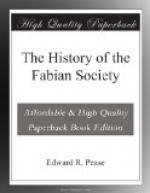The Labour Party won three remarkable victories in the period between the General Election of 1900 and that of 1906. In 1902 Mr. David Shackleton was returned unopposed for a Liberal seat, the Clitheroe Division of Lancashire; in 1903 Mr. (now the Right Hon.) Will Crooks, an old member of our Society, captured Woolwich from the Conservatives by a majority of 3229, amidst a scene of enthusiasm which none who were present will ever forget: and five months later Mr. (now the Right Hon.) Arthur Henderson, who later became a member of our Society, beat both Liberal and Tory opponents at the Barnard Castle Division of Durham.
When the election campaign of 1906 began the Labour Party put fifty candidates into the field and succeeded in carrying no fewer than twenty-nine of them, whilst another joined the party after his election. Four of these were members of the Fabian Society, and in addition three Fabians were successful as Liberals, including Percy Alden, then a member of our Executive Committee.
Whilst the election was in progress Mr. H.G. Wells began the Fabian reform movement which is described in the next chapter. At that time he did not bring the Labour Party into his scheme of reconstruction, but some of the members of his Committee were then ardent adherents of that party, and they persuaded his Committee to report in favour of the Society’s choosing “in harmonious co-operation with other Socialist and Labour bodies, Parliamentary Candidates of its own. Constituencies for such candidates should be selected, a special election fund raised and election campaigns organised.”
The result was that a resolution proposed by the Executive Committee was carried early in March, 1907, directing the appointment of a Committee to report on “the best means of promoting local Socialist societies of the Fabian type with the object of increasing Socialist representation in Parliament as a party co-operating as far as possible with the Labour Party whilst remaining independent of that and of all other Parties.”
This, it will be observed, is a different proposition, and one which resulted in a lot of talk and nothing else. Bernard Shaw had the idea that there might be county constituencies in the South of England, where independent middle-class Socialists could win when Labour candidates had no chance. No such constituency has ever been discovered and the Fabian scheme has never even begun to be realised.




